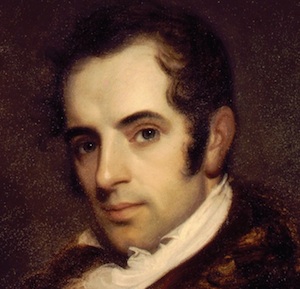 In the summer of 1817, two men hiking in the Scottish countryside ducked out of a rainstorm by huddling close together beneath a nearby thicket. One of the men pulled his thick tartan cape over the head and shoulders of the other, protecting them both from the wind and the wet until the storm had passed.
In the summer of 1817, two men hiking in the Scottish countryside ducked out of a rainstorm by huddling close together beneath a nearby thicket. One of the men pulled his thick tartan cape over the head and shoulders of the other, protecting them both from the wind and the wet until the storm had passed.
They were Washington Irving and Walter Scott, although even they hardly knew it yet.
At the time, Washington Irving was just another struggling American expat, desperately trying to beat the post-war economic slump and save the floundering family business abroad. He had always been a lousy student, despite having (eventually) passed the bar, and though he now gamely embarked on a crash course in bookkeeping and business, it would not be enough to save the business from bankruptcy.
And he knew it.
He’d been living on the residual fame of his earlier literary success for years now, having achieved some fame and notoriety as the barely pseudonymous author of A History of New York, the book that gave us the words Knickerbocker and Gotham as synonyms for New York. Following that, he had served as the editor of a reasonably successful American literary journal, mostly confining himself to pirating and reprinting works from England before they were published in America, and writing sentimental biographies of the naval heroes of the War of 1812.
It was hack work, but he didn’t honestly have much else to do. And he needed the money.
When his brother Peter’s shipping business in Liverpool starting circling the drain, he tried to help. He wasn’t much good at it, though, which was depressing, and he took to brief respites of travel during which he might forget his troubles and scribble down half-formed bits of ideas in his journal.
The writing wasn’t coming easy for him these days, either.
A friend had given him a letter of introduction to Walter Scott, who was living about twenty miles southeast of Edinburgh, and who had expressed himself an admirer of Irving’s History of New York. Irving set out for Edinburgh, determined to make the man’s acquaintance if he could.
Scott was not yet Sir Walter Scott. He had not yet published Ivanhoe, or Rob Roy, or Kenilworth. He was widely acclaimed as a Romantic poet, though, and it was in this role that Irving knew him. Admired him. Okay, he idolized him. Irving disliked Coleridge, disliked Wordsworth, disliked Shelley. But Scott, he adored.
So he appears on Scott’s doorstep, letter in hand, heart pounding, waiting to see if his idol will deign to see him.
He does more than that. Scott insists that Irving join him and his family for breakfast, then keeps him as a close companion for the next three or four days, introducing him to his daughters, showing him the local landscape, and going over with him the drafts of Rob Roy that he was finalizing at the time.
The incident of the rainstorm, the thicket, and the tartan cape was one that Irving would retell over and over throughout his life. He always felt that Scott had taken him under his wing — literally and figuratively — from that time on, and counted his friendship as among the most important and influential in his life.
More immediately, Irving took heart — and inspiration — from his visit with Scott.
His mood improved, and he finally decided that he would earn his living as a writer, or not at all.
In short, he got down to the business of his life.
Several weeks later, Irving’s writer’s block crumbled into dust. He stayed up all night and into the next morning, setting down in nearly final draft form the story that would become known as Rip Van Winkle. Shortly thereafter, he began work on The Legend of Sleepy Hollow.
Both men would eventually become the literary heroes of their respective countries, inspiring and influencing countless writers and readers who followed in their wake.
Charles Dickens was a big Irving fan, and admitted that he was inspired by the Christmas stories in Irving’s Sketches when he wrote A Christmas Carol. Mark Twain would later claim — disparagingly — that Scott’s writings formed the foundation of the character of the American South, so widely were they read there.
Scott would receive his baronetcy, and Irving would be hailed as the first true American man of letters, his warm, graceful home in New York’s Hudson River Valley becoming nearly as famous as he was.
But they both always remembered their first meeting in the summer of 1817, how instinctively and immediately they became friends, and how much they valued each other’s company and support throughout all the long, complicated years ahead.
Beth Dunn is a blogger, novelist, and geek. She writes at An Accomplished Young Lady, travels frequently to the Hudson River Valley, and presents herself unapologetically on the doorsteps of her literary heroes from time to time, quite often with absolutely marvelous results.
